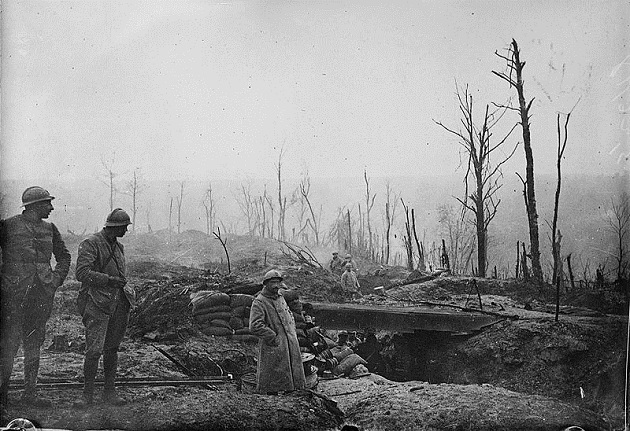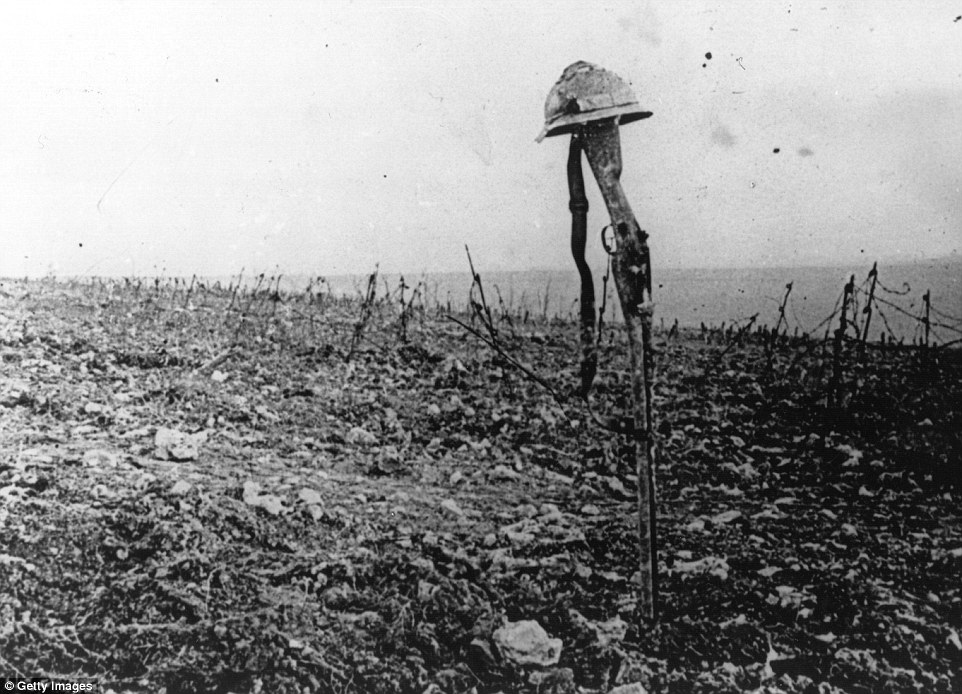Petain: Tell Your Troops, Hold Fast.
For German Command, ‘No Success Anywhere’
Special to The Great War Project
(26-28 February) The carnage at Verdun continues unabated.
Reports historian Martin Gilbert, the German daily assaults and shelling are ferocious. But while the Germans savage the French defenders, they “failed to give the Germans their entry into the city.”

French infantry under fire from German artillery during the Battle of Verdun, 1916.
With great speed, the French deploy reinforcements. “In the week beginning on February 27th,” reports Gilbert, “the French brought to Verdun…190,000 men and 23,000 tons of ammunition.”
“That same week an unexpected spring thaw turned the battlefield and the road into a sea of mud, but mud was no deterrent to the continued fighting, or to the intensity of the artillery barrages.”
The Battle of Verdun is to last for months, and it is proving to be very difficult for the Germans, unexpectedly so.
Gilbert reports that “in the first five weeks of conflict at Verdun, German soldiers were killed at the astounding rate of one every forty-five seconds.”

A fallen French soldier at Verdun, 1916.
“French deaths were even higher.”
“Ultimately on this one sector of the Western Front,” writes a biographer of the Kaiser, “the Germans suffered a third of a million casualties in occupying a cratered wasteland half the size of metropolitan Berlin.”
The German plan to destroy Verdun is a strategy concocted by the German commander-in-chief, Erich von Falkenhayn. Like so many other decisions made on both sides of this war, it is profoundly defective, writes historian Norman Stone.
The Germans unleash two million artillery shells along an eight-mile front, but “it was not long enough to deal with” the French positions. The German flank is vulnerable.
“The defending commander, Philippe Petain, knew what he was about, and German momentum slowed.”
“The French did not collapse – quite the contrary,” and key German initiatives fail miserably. “Meanwhile,” writes Stone, “Verdun became transformed into a national epic…and France was galvanized.”
Actually “public opinion was whipped up on both sides,” and Falkenhayn’s initial plan to stay out of Verdun proper and “bleed the French army white,” is cast aside.
On February 28 a century ago, the death toll on the German side leads to an emergency conference with key German generals including the German Crown Prince. “Although surprise had been lost,” writes historian Gilbert, the Prince concludes that “the prospects of a considerable moral and material victory remained. What was needed to secure this was the necessary quantity of men and materials to continue the offensive ‘not by driblets, but on a large scale.’”

French soldiers on the devastated battlefield at Verdun, 1916.
But the German command is facing some of the most determined generals in the French army, led by Petain. They see “the fight for Verdun,” writes war historian John Keegan, “as a test of [their] country’s capacity to sustain the defense of the national territory and keep alive the hope of ultimate victory.”
Petain makes his strategy crystal clear. He tells his officers, “I have taken command. Tell your troops. Hold fast.”
The German commander Falkenhayn desires a real set-piece battle of two huge armies at Verdun. But that is not what he gets.
“He had not counted upon the fervor the French would show,” writes Keegan. “Already on 27 February the Germans recorded ‘no success anywhere.’”
Among the French officers wounded and captured that day is the young Charles de Gaulle.
The Germans attempt to push artillery closer to the front, using an enormous number of horses. They are not successful, and in addition to appalling German casualties, seven thousand horses are killed – in one day.

Helmet and rifle mark where a soldier fell, Verdun, 1916.
But the French line would not shift, reports Keegan. “By 27 February,” he writes, “the Germans had advanced four miles and were within four miles of the city, but no increase in offensive effort could push their front forward.”
